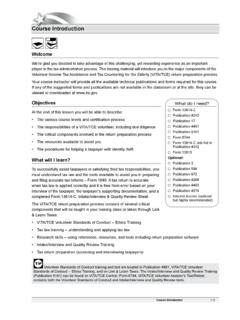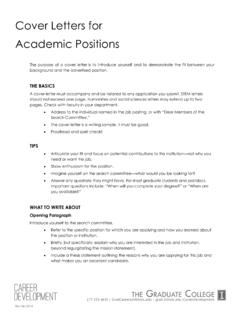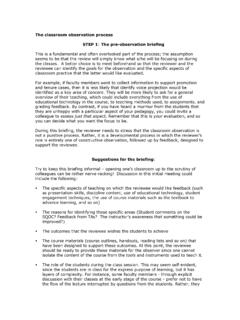Transcription of Basic Computer Literacy and Essential Skills
1 Basic Computer Literacy and Essential SkillsFacilitator s GuideBasic Computer Literacy and Essential SkillsFacilitator s GuideCopyright 2015 Community Learning NetworkMinistry of Innovation and Advanced Education, Government of AlbertaDevelopers: Darlene Thompson and Brad WhiteFacilitator Basic Computer Skills : Brad White Project Manager and Editor: Shannon YatesAwasisak & Family Development Circle would like to thank the facilitator s assistants for their help and the learners for their commitment to the to the Awasisak & Family Development Circle Board of Directors for their support in this & Family Development CircleBox 2360 Lac La Biche, Alberta T0A 2C0 Facilitator s guideBasic Computer Literacy and Essential SkillsContents4 Introduction10 Module 1: Introductions and program overview15 Module 2: Basic Computer functions and Gmail account setup 22 Module 3: Review of Modules 1 and 225 Module 4: USB port, memory stick, mouse and folders 31 Module 5: Program wrap-up34 Appendix 1: Principles of adult learning and helping Skills 40 Appendix 2: Introduction to Essential Skills44 Forms1.
2 Registration Form2. Permission to Use Picture3. Attendance Record48 Handouts1. Program Overview2. Computer Terms3. Learner Journal4. Essential Skills in the Workplace and in Daily Life5. How to Use a Wireless Mouse6. Similarities and Differences between Windows and Google Chrome Features7. Common Features of Windows8. How to Install Google Chrome9. Google Screens10. How to Set Up Gmail Account11. Gmail Account Access12 . Purpose of App Launcher13. Understand the Email Toolbar14. Use an Educational Application 15. Share and Add an Email Address and a New Contact 16. Send an Email17. Format an Email18. Delete and Recover an Email19. Add a Picture to your Google+ Profile20. Working with Folders21. Google Search and Save to Memory Stick22. Create a Document and Attach to Email23.
3 Google HangoutsIntroduction 4 Facilitator s guideBasic Computer Literacy and Essential SkillsIntroductionOverall aim of the program welcome to the Basic Computer Literacy and Essential Skills Facilitator s Guide. The activities in this program address the needs of learners who want to learn Basic Computer Skills to enhance their employability or for their personal interests and goals. The Basic Computer Literacy and Essential Skills (BCLES) program is aimed at adult learners who have low-level Computer Use Literacy and very limited experience with the functions of a Computer . To improve Computer Literacy , the learners are introduced to and use Windows and Chrome programs. Target learner characteristics The program is designed for older learners who are between forty and sixty years of age with highest level of education completed ranging from Grade 8 to Grade 12.
4 The materials and activities are geared to Level 2 Reading Literacy , meaning learners have the ability to read activity instructions on the projection screen, Computer screen and handouts without assistance. Learners with Level 1 Computer Use Literacy and with very limited to no Basic Computer experience will benefit the most from the program. Learners at this level require one-on-one assistance at the beginning of the program but as Skills and confidence build, less one-on-one assistance is expected. To provide good instruction, learners need only one factor in common: Level 1 Computer Use Literacy . Apart from this one factor, the learner population can come from all walks of life as was evidenced in the first program from which this guide was developed. A snapshot of the learners who took this program provides glimpses into their backgrounds: store manager, post office clerk, homemaker service worker who works with seniors and disabled clients, gravel scale operator, community business owner, community member who is a foster parent, handicapped community member, senior from the Elder s Advisory Committee, childcare supervisor, homemakers and Aboriginal Head Start staff.
5 Desired learner outcomesThe desired outcomes for the learners in this program are to: Understand Basic Computer terminology Perform the Basic functions of using a desktop Computer , laptop or Chromebook Know Google Chrome features and how they are used with a Windows operating system or Chromebook Use their learned Skills to seek employment opportunities Improve their Computer Literacy in their current jobs Meet a personal goal Access other learning opportunitiesIntroduction 5 Facilitator s guideBasic Computer Literacy and Essential SkillsBefore launching into the activities, take a few minutes to read the following paragraphs and review Appendix 1: Principles of Adult Learning and Helping Skills as well as Appendix 2: Introduction to Essential adult learning programs or working one-on-one with an adult learner starts with a Basic understanding of adult learning principles.
6 Take a minute and reflect on your experiences as an adult learner, you may find that what made your experience either positive or negative was directly related to the instructor s knowledge about adult learning principles. Specifically, being recognized for the wealth of experience you ve accumulated, your desire to learn, and your independence as a , equally important to understanding adult learning is having a good grasp of communication process fundamentals that aid in moving your learner towards meeting goals. In addition, since the focus of the activities described in this guide is to increase the learners Literacy in some or all of the nine Essential Skills , refreshing your memory about the Skills and the Literacy levels will make for more effective facilitation. Program contentThe program consists of five modules comprised of ten 3-hour classes.
7 The activities for each class require approximately three hours to complete. The module starts with a statement of purpose, identifies objectives, describes the activities and provides step-by-step instructions on how to complete each activity. Handouts are included for each activity; the table of contents lists all forms and handouts used in the program. The program takes the learner from learning how to turn on a Computer to setting up an email account including attaching documents. In each activity, the focus is on one or more of the following Essential Skills : Oral Communication, Continuous Learning, Working with Others, Document Use, Reading, Writing, Computer Use and Thinking. It is important to remember that Essential Skills are not tasks, rather Essential Skills are used to complete a task.
8 Each activity requires a number of tasks to improve the learners Computer Literacy . Following are some of the tasks to be learned in the program and the required Essential Skills needed by the learners to complete the tasks: Oral Communication: use speech to provide or share thoughts and information during sessions with facilitators and other learners Continuous Learning: learn new terminology and Basic Computer Skills in a group setting using a variety of instructional methods (handouts with screen shots, written and verbal step-by-step instructions) Working with Others: group work and one-on-one with a partner and/or staff Document Use: use registration and evaluation form Reading: read information from a projection screen and Computer screen, read forms and handouts Writing: complete forms.
9 Make notes in Learner Journal Computer use: follow step-by-step directions to learn and use Basic Computer functions Thinking: decision-making regarding program sign-up; learn how to use a Computer and apply learning to real life situationsIntroduction 6 Facilitator s guideBasic Computer Literacy and Essential SkillsMost of the Essential Skills have a task complexity level rating. For example, Computer Use skill is rated on a five level scale of complexity. These skill levels indicate the complexity level involved in the use of a skill for a particular task. The level indicates the complexity involved in the use of Computer Use Skills to perform particular Computer -related tasks. For all Skills , the least complex tasks are tasks at Level 1. The most complex tasks are classified at Level 5.
10 Keep in mind that Essential Skills complexity levels measure the complexity of a task, not the performance level of the learner. Five level scale of complexity for Computer Use Essential Skill Level 1 Performing tasks that require only Basic interaction with Computer -controlled machinery or equipment such as entering given codes to unlock equipment, responding to light-emitting diodes [LEDs] Using only a few Basic commands with no knowledge of software required such as sending an e-mail message to one personLevel 2 Performing tasks that require the use of several simple software features such as formatting a letter Using software for a limited number of functions that make use of existing structures or standard formats such as entering data onto a given formLevel 3 Performing tasks that involve several operations and the use of a wide range of software features or options such as formatting complex documents, setting up and configuring software Performing various kinds of tasks that may involve some experimentation to achieve the desired resultsLevel 4 Performing complex tasks that involve several operations and the extensive use of software features.







